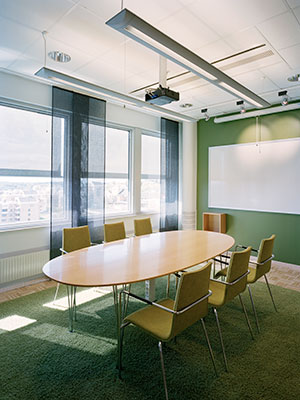Comparison of control methods
LED
Dimming of LED is made by the same principles as the control of fluorescent lamps. Another common control principle for LED is DMX. See fact box.
Drivers with pulse width modulation (PWM) is available with different types of control interface such as DALI, DSI, DMX 512 and phase pulse control. PWM units are also available as separate units to be connect between ballasts with constant voltage and load. Read more on pages that describe LED control.
Fluorescent lamps
 In general there are four different control methods for fluorescent lamps with HF-ballasts. Control method refers to the type of signal transfer used between the control unit/controller and the HF-ballast in the luminaire. A number of the most common control methods are highlighted in the table below.
In general there are four different control methods for fluorescent lamps with HF-ballasts. Control method refers to the type of signal transfer used between the control unit/controller and the HF-ballast in the luminaire. A number of the most common control methods are highlighted in the table below.
The selected method also effects, apart from the components included in the system, how low the lighting can be regulated, how the installation is performed and the cost of the system. Digital systems are generally more expensive than analogue, but they offer technical and functionality advantages that truly substantiate the extra cost.
In some applications it may be beneficial to combine digital systems with basic analogue systems. Read more about this on the DALI pages.
|
Characteristics
|
DMX
|
DALI
|
DSI
|
Phase-pulse control
|
1-10 V
|
|---|---|---|---|---|---|
| Addressable luminaire control | 512 | 64 | No | No | No |
| Group addresses | No | 16 | No | No | No |
| Logaritmic control | No | Yes | Yes | Yes | No |
| Control circuit polarity dependant | Yes | No | No | - | Yes |
| Switched off via the control circuit | Yes | Yes | Yes | Yes | No |
| Number of conductors to the luminaire | Separate control cable | 5 | 5 | 4 | 5 |
| Control circuit in same cable, max length | No | 300 m | 250 m | Unlimited | 300 m |
| Multi-channel systems require an external central unit | Yes | No | Yes | Single channel | Yes |
Facts DALI – Digital Addressable Lighting Interface
Advantages
- Components from several different manufacturers can be included in the same system.
- Each unit in the system is addressable.
- Easy to modify and expand.
- Only one pair of control conductors even in multi-channel systems give lower installation costs.
- Polarity free control conductor reduces the risk of wrong connections.
- Can be controlled via an interface by a computer.
- Can be connected to a BMS-system (LonWorks, EIB) via a gateway.
Note
- The system must be programmed before commissioning.
- Programming is performed in different ways for products from different manufacturers.
- Max 64 addresses/system (Note that the interface for programming via a computer requires an address).
- Large systems can be built up via software/servers/gateways. This type of system usually utilises existing data networks (TCP/IP). An example of this type of system is winDIM@net from Tridonic.
Facts DSI – Non-addressable digital control
Advantages
- All luminaires are controlled in the same way thanks to digital data transfer.
- Polarity free control conductor reduces the risk of wrong connections.
- Can be controlled via a computer.
Note
- Components in the system are not addressable.
- Multi-channel systems require each channel to have a separate control conductor.
- Only one manufacturer of the system.
Facts Phase-pulse control – Impulse control – for example, switchDIM
Advantages
The system does not need an advanced control unit.Standard momentary switches can be used.Only one extra phase conductor is required in the control circuit.
Note
- Wall switches must not be fitted with an indicator.
- The function can easily get out of sync due to network disruption or short key presses.
- Avoid mixing different brands in the system.
- Do not use more than 4 HF ballasts to regulate the control.
Facts 1–10 V – Analogue control
Advantages
- Known system that is easy to understand.
- Control units available from most manufacturers.
Note
- Some analogue 0–10 V control systems on the market are not appropriate for the control of control gear for 1–10 V DC as set out in EN 60929.
- The length of the control conductor can affect the control result.
- 1–10 V systems can only be controlled from one location (one control unit).
Facts DMX 512 – Digital control
Advantages
- Known systems with many control options, lightbox, software, etc.
- Ideally suited to operate the RGB control of the LED.
Note
- Special requirements for control cable and installation.